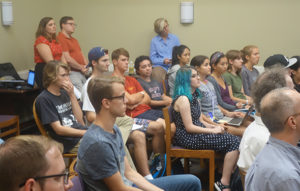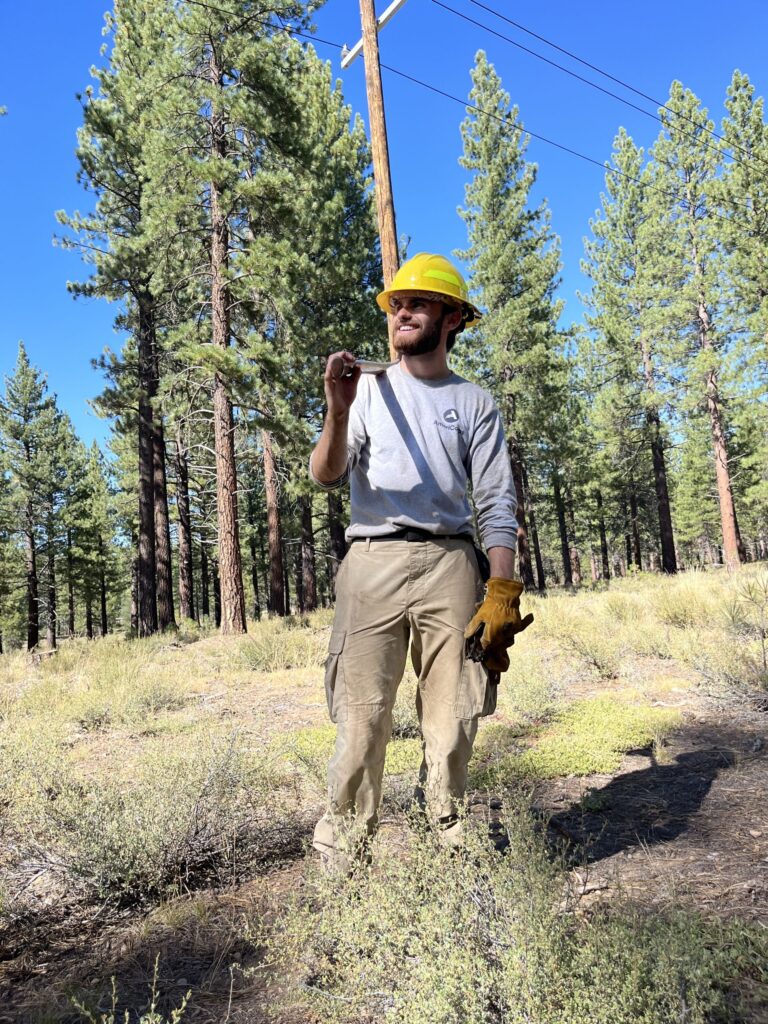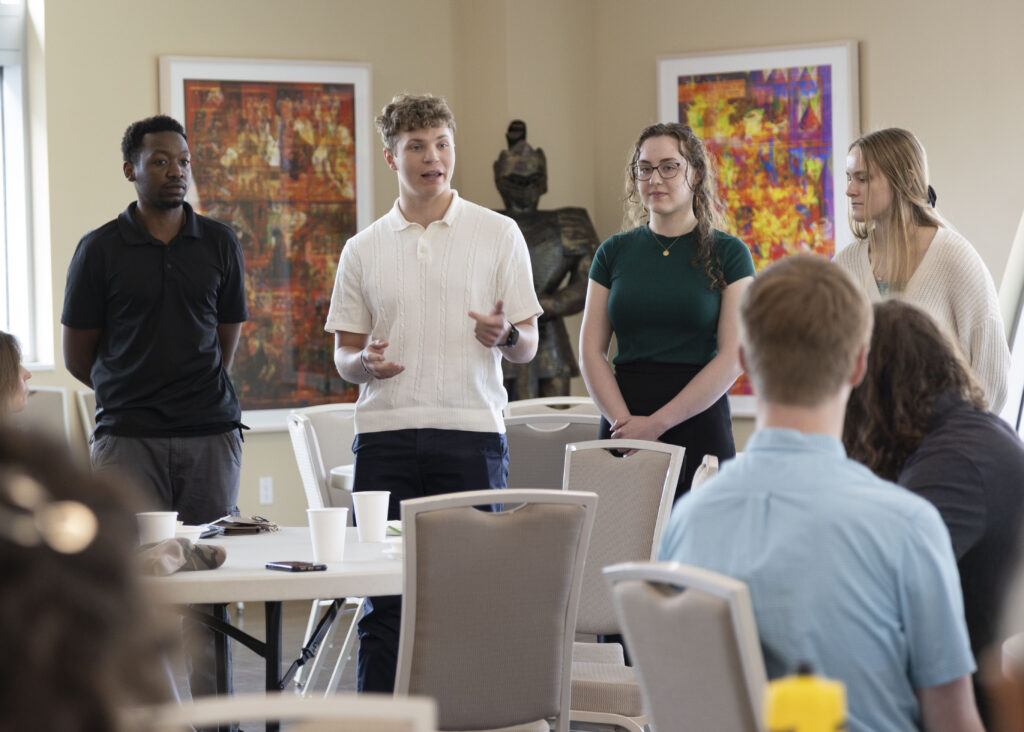College instilled service ethos for NYC theater work
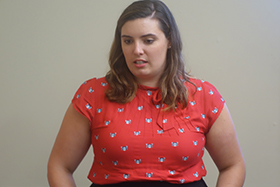
Above headine, Heather Fichthorn speaking in the Farrell Room Tuesday (closeup directly above); descending below, introduction by Peter Vantine, Heather speaking after talk with students and faculty; crowd (Heather back at left) listens during introduction. (Photos by Mark Tarnacki)
A creative launch pad for the hit Broadway show Hamilton was The Public Theater in New York City, where Heather Lessard Fichthorn ’12 is company manager.
She told about 50 people, mostly First Year Seminar students, during a campus appearance Sept. 18 in the Farrell Room, that when it comes to the aspects of life that really count, she easily can draw parallels between her present professional world and Saint Michael’s, which she realizes was her own personal launch pad into a satisfying early career of service doing something she loves and was well-trained to do.
“Saint Mike’s is community. It is collaboration and conversation. It’s a family and connection. It is about being given the freedom to create and the opportunity to debate. It is a passion for justice,” Fichthorn said in her talk — right after she had identified many of those same qualities as key to The Public Theater’s mission and success.
During her campus visit, Fichthorn also spoke to classes on both Tuesday and Wednesday, though the immediate reason for her invitation was that first-year Saint Michael’s students are studying Hamilton: The Musical as their first-year Common Text, with a series of related guest speakers. The evening talk was titled “The Room Where it Happened; The Road to Broadway and Why I Chose Non-Profit.” Peter Vantine,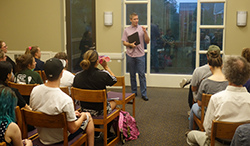 director of First Year Seminar, introduced her 7 p.m. talk, which also was attended by several faculty including Will Marquess of English, Peter Harrigan and John Devlin of Theater and Mary Beth Doyle of Education.
director of First Year Seminar, introduced her 7 p.m. talk, which also was attended by several faculty including Will Marquess of English, Peter Harrigan and John Devlin of Theater and Mary Beth Doyle of Education.
With absorbing personal detail about her encounters with often high-powered theater figures and other celebrities, balanced against the daily challenges of more mundane logistics that she oversees, Fichthorn began by explaining how Hamilton had a workshop production at The Public Theater (located down between Greenwich Village and the East Village of Manhattan) in her early years working there before the show hit it extra-big on Broadway, offering her rare insights into this show that students now are studying.
“I spent most of my time filling ticket requests, answering phones and prepping for rehearsals,” she said of those earliest days in the development of the show Hamilton as cast and crew were working out any kinks and polishing the production. Once a buzz had started about the extraordinary show, it was clear the Public had “never done a workshop this big,” she said, describing her memory of hearing some of the early songs, and of the artistic director sobbing over their power, which became a source of comfort over that director’s loss of a son. “Even in its unfinished state, it was having impact,” Fichthorn said.
Amid all of those early Hamilton rumblings, however, Fichthorn went back to Vermont shortly after the workshop production had begun for a summer job with Saint Michael’s Playhouse, where she previously had worked while a student, leading to connections that had gotten her the job at The Public initially. Happily, she said, The Public hired her back later as the general manager’s assistant, when she discovered dramatic changes at her old workplace thanks to Hamilton: for example, her old department, which only had 5 people in it before, now had 18 due to the “crazy buzz” about the exciting new show.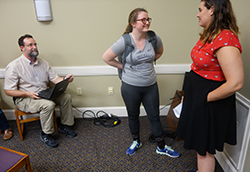 “World spread, and everyone wanted to be in the room,” she said. During rehearsals at The Public, Hamilton’s author and star Lin-Manuel Miranda was still writing the show, she said, and “he would often work in our empty office so we’d hear him plinking tunes on the keyboard and singing the word ‘Hamilton’ in different pitches.”
“World spread, and everyone wanted to be in the room,” she said. During rehearsals at The Public, Hamilton’s author and star Lin-Manuel Miranda was still writing the show, she said, and “he would often work in our empty office so we’d hear him plinking tunes on the keyboard and singing the word ‘Hamilton’ in different pitches.”
She and relatively few other people got to see parts of an earlier the show that involved water and a reflecting pool for Hamilton to recall memories – a section later cut. She saw her share of celebrities coming to see the show early on – Jennifer Lopez or J-Lo, Bon Jovi, Jimmy Fallon, Michelle Obama, Madonna … even Dick Cheney. Barely six months after the show opened at The Public, its producers announced it would transfer to Broadway, which was major press event, unlike with most shows when they are moving from The Public.
Hamilton “changed the way we produced theater at The Public,” she said, since with every show after that, “people wondered if it was the next Hamilton!” – and some were in fact great successes – Eclipsed, Latin History for Morons and Sweat for example– though not all shows went on to such fame by any stretch.
Fichthorn talked about “the philosophical connection between Saint Mike’s and The Public” she came to understand: “I sought out a job that strives for social justice, a place that believes in taking chances, a place that gives artists the freedom to create. The Public takes chances on people others might not, and I think Saint Mike’s is very similar.”
Saying 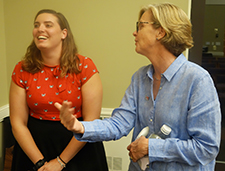 that “being on campus has felt like coming home, she spoke of her grief at news on Monday about the death of her former St. Mike’s theater faculty mentor Cathy Hurst, yet said she was glad to be among such a strong community at such a time. “Being here to talk is a comfort, to hold onto those connections. You don’t realize the power of St. Mike’s till you really need it,” she said.
that “being on campus has felt like coming home, she spoke of her grief at news on Monday about the death of her former St. Mike’s theater faculty mentor Cathy Hurst, yet said she was glad to be among such a strong community at such a time. “Being here to talk is a comfort, to hold onto those connections. You don’t realize the power of St. Mike’s till you really need it,” she said.
She described at some length her favorite program at The Public called Mobile Unit: “We take theater to all five boroughs of New York City and bring theater to people who cannot come to us,” Fichthorn said of the nine actors, two stage mangers, a producer, company manager, production manager, tour tech and cargo van. “They show up, roll out a carpet, turn out whatever lights they have, set out as many chairs as we can find and put on a show” — with a boom box for soundtrack — in homeless shelters, libraries, prisons, rec centers and community centers.
“We leave the traditional conventions of theater behind and take these two hours to share space together, to simply be human together,” Fichthorn said. “That is why I do the work that I do. And I think without even realizing it, it was my time at Saint Mike’s that really instilled that value in me, and for that I am grateful.”